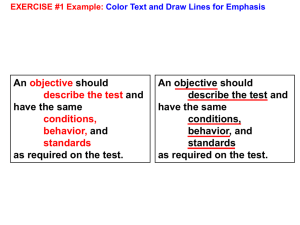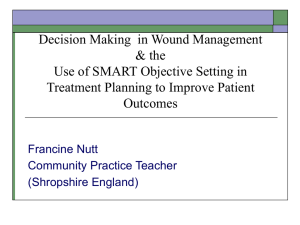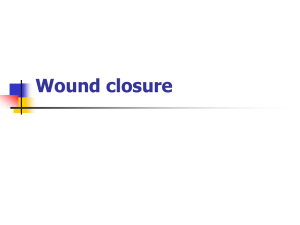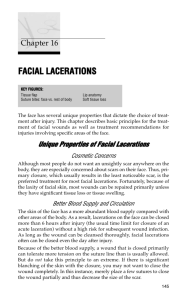cornealaceration
advertisement
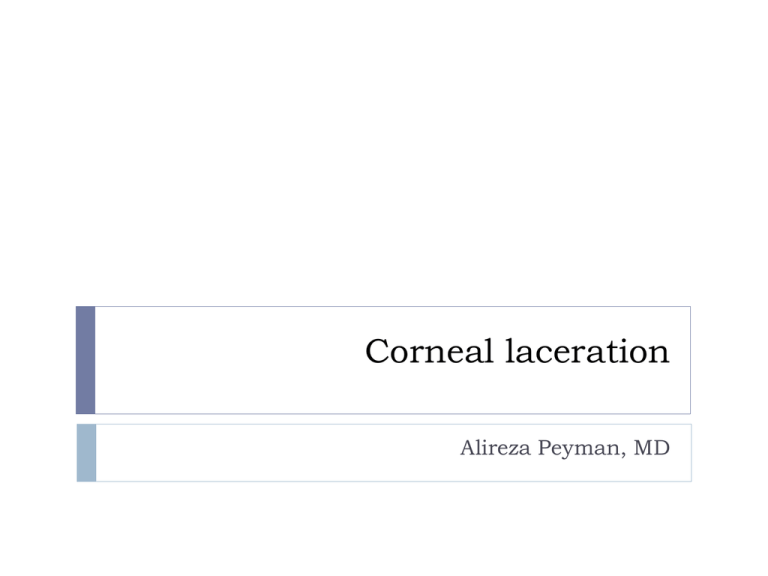
Corneal laceration Alireza Peyman, MD Surgical repair The primary goal is to achieve a watertight globe and maintain structural integrity. Secondary goals include: removing any disrupted lens fragments and vitreous repositioning any uveal tissue relieving vitreous incarceration removing any intraocular foreign bodies restoring normal anatomic relationships Partial-Thickness Corneal Lacerations Must be examined carefully to rule out any rupture of Descemet Seidel testing Modified Seidel testing If the wound edges are in good apposition with no wound gape, pressure patching with the use of prophylactic topical antibiotics is sufficient. If the wound is unstable, a bandage soft contact lens may be used to support the wound Partial thickness laceration with gape Sutures may be used to re-approximate the wound margins. In these settings, properly placed sutures will minimize scarring and perturbation of the ultimate surface corneal topography Full-Thickness Corneal Lacerations BANDAGE SOFT CONTACT LENS For small, self-sealing corneal perforations, a bandage contact lens may be sufficient Such lacerations include nondisplaced, beveled, self-sealing wounds. If aqueous leakage persists for more than 24 hours or there is progressive shallowing of the anterior chamber, more definitive treatment should be undertaken In cases that respond satisfactorily, the contact lens should be kept in place until the wound has stabilized (usually 3–6 weeks). A protective shield should be worn at all times. Topical antibiotic prophylaxis and cycloplegia are recommended with the lens in place. TISSUE ADHESIVE. Tissue adhesive may be useful for puncture wounds with small amounts of central tissue loss and selected small lacerations. It is not routinely utilized. SUTURE REPAIR OF SIMPLE CORNEAL LACERATIONS The primary goal of corneal suturing is to achieve a watertight wound. Secondary goals include minimizing scarring restoring normal anatomic relationships reconstructing the normal corneal topographic contours For a wound that is less stable, a viscoelastic may be irrigated into the anterior chamber either directly through the wound itself or through a separate limbal paracentesis incision visco through the wound or through a paracentesis incision will help To form the chamber: Balanced salt solution or air may also be used to re-form the anterior chamber. In most cases, a limbal paracentesis with a A 15-degree sharp microsurgical knife is preferred because it will minimize disruption of the wound edges and permit better access as the case proceeds Temporary sutures Temporary sutures may be used if the initial placement of deep definitive sutures would cause loss/flattening of the anterior chamber. The number of temporary sutures should be minimized, however, to prevent undue trauma to the wound margins Technique and material For corneal suturing, 10-0 monofilament nylon on a fine spatula-design microsurgical needle is used. The simplest method is to progressively halve the wound with simple interrupted sutures. Corneal sutures should be 90% to 95% depth through the stroma 1.5 mm in length of equal depth on each side Shallow sutures create internal wound gape, whereas sutures of unequal length and depth on each side of the wound result in wound override. Deep suture placement equidistant from the wound margins gives excellent wound approximation Shallow sutures create internal wound gape Full-thickness sutures may create a conduit for microbial invasion Sutures of unequal depth create wound override. Sutures of unequal length create wound override For shelved lacerations, sutures should be placed equidistant with respect to the internal aspect of the wound to achieve good wound apposition Making the suture bites close to the visual axis short “no-touch” technique When using a running suture for a nonlinear laceration, the suture should be placed with respect to a straight “regression” line Suture knot burial STELLATE CORNEAL LACERATIONS Bridging sutures Purse-string suture multiple interrupted sutures and tissue adhesive or patch graft CORNEAL LACERATIONS WITH UVEAL PROLAPSE. Iris incarceration A peaked pupil signals tissue incarceration Macerated, feathery, devitalized, or depigmented iris should be excised The prolapsed tissue should be evaluated for any signs of surface epithelialization. In this case, it should be excised to prevent any epithelial cells from proliferating in the anterior chamber In general, tissue that has been prolapsed for longer than 24 hours should be excised to avoid infection; however, if the tissue appears healthy, it may be replaced with caution. Repositioning Pharmacological Midriatics Myiotics Mechanical simply deepening Viscoelastics through the paracentesis or the wound a spatula or irrigating canula may be passed through the paracentesis site and used to directly sweep incarcerated tissue CORNEAL LACERATIONS WITH LENS OR VITREOUS INVOLVEMENT Primary removal of the lens Disrupted capsule and flocculent cortical material liberated into the anterior chamber. In cases in which vitreous is involved with lens remnants, this may be best addressed in the initial surgery. When it is clear that a lens is cataractous and surgical visualization is good, the lens may be removed in the primary operation. Vitreous strands are swept into the anterior chamber CORNEOSCLERAL LACERATIONS For large lacerations with structural deformation, sutures should be placed to restore wound integrity before rigorous exploration of the globe Initially, the limbus should be reapproximated with 8-0 or 9-0 nonabsorbable nylon or silk sutures. it is important to clear the wound of any prolapsed or incarcerated vitreous with dry cellulose sponges and cut options in selecting suture material for scleral closure Some surgeons prefer nonabsorbable sutures Others may use absorbable materials For larger defects, nonabsorbable sutures should be used closing sclera over prolapsed uvea Most easily closed from the anterior (limbal) end “ zippering” or “close-as-you-go” technique. sutures are placed in close proximity to one another in an attempt to achieve oversewing of the uveal tissue with the sclera. Posterior extention scleral lacerations may extend far posteriorly, and may not be accessible. In these situations, it is preferable to leave the most posterior portion of the wound unsutured The sclera is thinnest behind the muscle insertions; thus, careful exploration of these areas is crucial ANTERIOR SEGMENT FOREIGN BODIES FBs Metalic Vegetable matter Glass Plastic Stones Other materials Typically, the foreign body is small and the eye may not show obvious signs of trauma Foreign bodies frequently lodge in the anterior chamber angle and may display overlying focal corneal edema. Gonioscopy may be useful in detecting the foreign body may also embed themselves in the lens and may create a focal cataract. Iris transillumination defects may signal an entry site. Imaging Plain graphies CT MRI B-scan sonography UBM Removal Through an incision directly overlying From a limbal incision across the anterior chamber Post-op management Medical therapy To control infection To suppress inflammation To stabilize the ocular surface Antibiotics Sub-conjunctival Intra-vitreal Vanco or cephalosporine+AG Topical Intra-op IV Intra-op Fortified, or 4th generation flouroquinolones Oral After discharge Clindamycin should be considered in cases involving vegetable matter to cover Bacillus species. Top: 50mg/ml Subconj: 50mg/0.5ml Intravitreal: 1mg/0.1ml Corticosteroids To minimize scarring and new vessel ingrowth The anti-inflammatory advantages against the risk of infection May also diminish the rate of stromal healing as well as the tensile strength of the wound Corticosteroid use should be kept at a minimum in the early postoperative period Others Topical β-blockers Carbonic anhydrase inhibitors Lubricants Bandage contact lenses Patching Tarsorrhaphy Thank you for your attention

